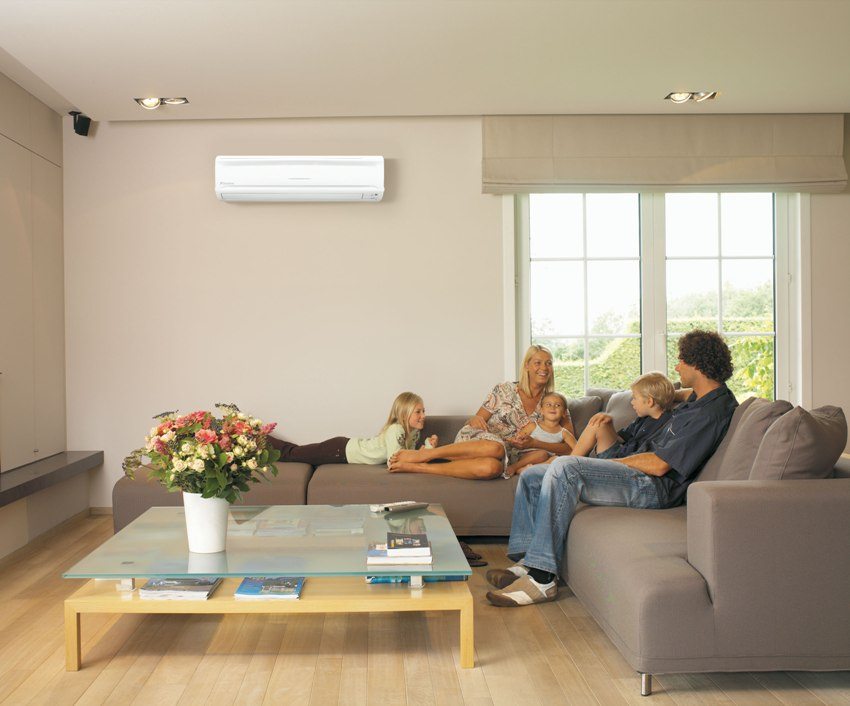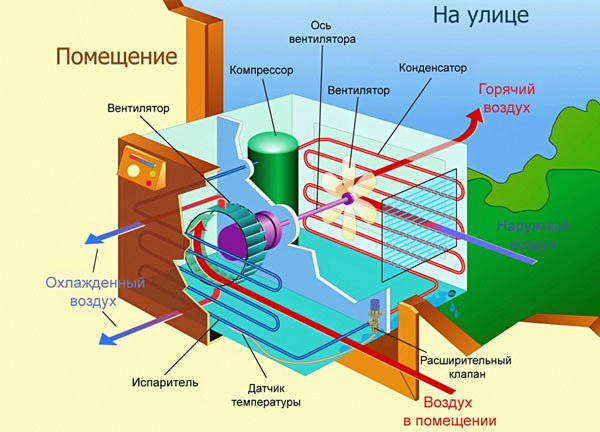 If you intend to purchase a high-quality fan for your home or a specific room, you definitely need to calculate its optimal cooling power. So you can choose an air conditioner that will most effectively perform its functions in your home, taking into account its specifics.
If you intend to purchase a high-quality fan for your home or a specific room, you definitely need to calculate its optimal cooling power. So you can choose an air conditioner that will most effectively perform its functions in your home, taking into account its specifics.
Cooling power (MO) is often confused with power consumption. But these are different indicators. The first parameter is several times greater than the second.
Example: an air conditioner needs 700 watts, and its MO = 2 kW. And the ratio of these parameters is the energy efficiency of the air conditioner (EER). For household appliances, the EER is 2.5-4 units.
There are few methods for determining the MO for an apartment:
- Using calculators on the Internet.
- By the squares of the room.
- According to special formulas. They take into account the volume of the room and the sources of heat in it.
- Thermophysical calculation of enclosing elements. Calculation is implied for summer time. It takes into account additional heat.
Of these methods, the fourth is the most difficult. They are usually operated by design specialists.
Content
Using Online Calculators
This is the easiest way. But he has one flaw. The user does not know how the calculation is carried out, which parameters of thermal receipts from various sources are loaded into the calculation program. In some cases, the program may have too much reserve. In the end, you will have to pay for it.
But if this does not bother you, then you can quickly calculate the necessary parameters. The calculation is based on the parameters of the room, the number of its residents, the level of ventilation and other indicators.
You can choose a model for certain conditions. So, for office premises and small rooms, devices with small power are needed. Here put portable, window or wall units.
Modifications with greater power are put in trading floors, clubs, warehouses, etc.
An example of one such calculator is proposed below.
In it, for example, some values are indicated on the basis of which the calculation takes place.
| Area of the premises, sq. m | Ventilation accounting | |||
| Ceiling height, m | Air exchange parameter | 1.0 | ||
| Insolation | average | |||
| The number of residents - 1 | ||||
| Number of computers: | 1 | |||
| Number of TVs: | 2 | |||
| Power of other household appliances: 900 | ||||
| Estimated MO (Q): | 3.10 kW | |||
| Recommended range of parameters | 2.94 - 3.56 kW | |||
If you are still afraid to do the calculation online and believe that the parameters are being wound here in order to receive a larger amount from the client, then you can carry out these arithmetic operations yourself.
Square-based operations
This technique is especially respected by sales representatives. She has some analogies with calculations of heating equipment by specific heat parameter.
The essence of the technique: if in the room the ceilings do not reach 3 m in height, then 100 W of cooling energy should be generated here per square meter.
So for a room of 20 sq.m. need a device with MO 2 kW.
If the ceiling height is more than 3 m, then the specific MO is calculated according to the following table:

To the expending parameter of the cold over the whole area of the room, one also needs to add power to compensate for the heat fluxes from the residents of the room and household appliances located in it.
Here the calculation is carried out as follows: from one tenant 300 watts of heat are emitted, from household units also 300 watts.
It turns out that if the room is 20 sq.m. 1 tenant constantly lives and he works with the computer, then another 600 watts are added to the calculated 2 kW. Result = 2.6 kW.
In practice, with reference to regulatory documents, if a person is at rest, then heat of 100 watts emanates from him. With minor movements - 130 watts. During physical exercises - 200 watts. It turns out that in these operations there is some overestimation of thermal parameters from people.
Room Based Operations
The most correct calculations of MO air conditioners are based on the specific cold parameter per cubic meter of space. These calculations are especially effective if the area is close to 70 sq.m.
How to select the air conditioners according to the area of the room? For operations, specific power is used (letter q). Its values under certain lighting conditions of the room are indicated in the table:
| Values W / cbm. | Light conditions |
| 30 | Shade |
| 35 | Average light |
| 40 | Sunny side |
The power to compensate for heat inflows through building components is calculated in this way:
Q1 = q x V, (V is the volume of the room).
With the condition that residents and household appliances are in the room, Q2 (heat from residents according to regulatory documents) and Q3 (heat from household appliances) are added to the calculated value (Q1).
Q3 varies depending on the goals of household appliances.
- When the computer is running, Q3 rises by 250-300 watts.
- When using office equipment - 30% of the absorbed electric power.
The calculation of specific power is as follows:
Q = Q1 + Q2 + Q3.
In this example, the ceilings in height reach 2.7 m. The volume is found as follows: 20 (area) x 2.7 = 54 cubic meters.
The average parameter of specific MO = 35 W / cubic meter. (according to the table). With his account, the operation is as follows: Q1 = 35 x 54 = 1890 W. Q2 and Q3 are added to the result. It turns out:
Q = 1890 + 130 + 300 = 2320 W.
Specific conditions for settlements
When calculating the MO, it is important to consider the following factors:
- Storeys of the premises. It can be located on the top floor of the building.
- The presence of non-standard windows. Their glazing can be large-scale. The roof may be transparent to light.
- There are a lot of people in the room (work room, office).
- The room can very often be aired. It can be a significant infiltration of external air.
- The abundance of household appliances.
- The ceiling, its height and distortions.
In such cases, the estimated efficiency of the air conditioner develops with a factor of 1.2 - 1.5.

Condition: window opens
If you open the window in the room, it is air from the street. The documentation for the air conditioner indicates that normal operation is obtained only with the windows closed. Otherwise, an excess of heat load will result.
Users turn off the unit from time to time and, after airing the room, start it up again for cooling. This causes some inconvenience. He does not work efficiently when the windows are open, that is, subject to ventilation. After all, the volume of air entering the room is not calculated at all. And it is extremely difficult to find out the excess heat load.
Solution: the door closes in the room, the window is ajar. Drafts are no longer observed in the room, but air in a modest amount is constantly inside.
How the device works in such a condition is not reflected in the documentation for it. And there is a danger that he will not be able to function normally in this mode. However, in most cases, this measure maintains comfortable cooling in the room. And periodically it is not necessary to air it. And if you intend to use the unit in this mode, keep in mind that:
- The power of Q1 necessarily increases by 20-25%. This compensates for the thermal effect of air inflow. This indicator is a parameter of air exchange (it is reflected in the calculators in the network). For residential premises, it ranges from 1 to 2.
- The absorption of electricity by 10-15% is developing.
- Sometimes heat inflows are very large, for example, in extreme heat. The device is not able to maintain the desired temperature. Then the window necessarily closes.
- Ideally, it is better to purchase an inverter unit, because it has a variable MO and works effectively at various thermal loads.
A device of another type, even with high power, can form uncomfortable conditions. A small room is the best place for this.
The final choice of power-based air conditioner
An example of mathematical operations was previously given, as a result of which a parameter of 2.32 kW was obtained. In fact, this is not the final indicator. After all, the necessary apparatus cannot constantly work at the limit of its potential. To arrange its work in a gentle mode, it is necessary to have a reserve of power. Usually it is 15-20% of the calculated indicators.
In the used example with the indicated values (20 sq.m. of living space, 2.7 m, 1 tenant, 1 computer), the calculation formula is obtained:
2.32+ 15% = 2.67 kW.
Many companies produce their devices in accordance with the gradation in force in the United States. It is based on the British Heat Unit (BTU). It corresponds to the standard values as follows: 1000 BTU / h = 293 watts.
In the technical documents for the air conditioner, a parameter is indicated that indicates the power in thousands of BTU. The beginning of the gradation is the value 7. This is equivalent to 7000 BTU or 2100 watts.
The following is a table of power devices. It reflects the ratio of BTU to regulatory units. It also indicates the approximate quadrature of the rooms into which each cooler can be placed from the line.

This table can be used for increased calculations of the power of the air conditioner.

Power differences
This issue has already been addressed. Now more about this. When choosing a split technology or other cooling device, it must be borne in mind that this is special equipment. According to the power criteria, it differs from electric heating units. The power consumption of the air conditioner, which is formed from electricity, differs from its MO.
In this example, the result was 2.67 kW per 20 sq.m. He may confuse some hosts. But the efficiency of such units is quite high due to the steam generation and condensation of freon (it is a working fluid). And in fact, the device absorbs three times less electricity. Thus, it is necessary to divide the indicator 2.67 by 3. That's how much it consumes in this case 0.89 kW.
Summary
We examined all the known options for how to choose an air conditioner by area. All that is necessary for the calculation is presented in the article with examples of calculations.